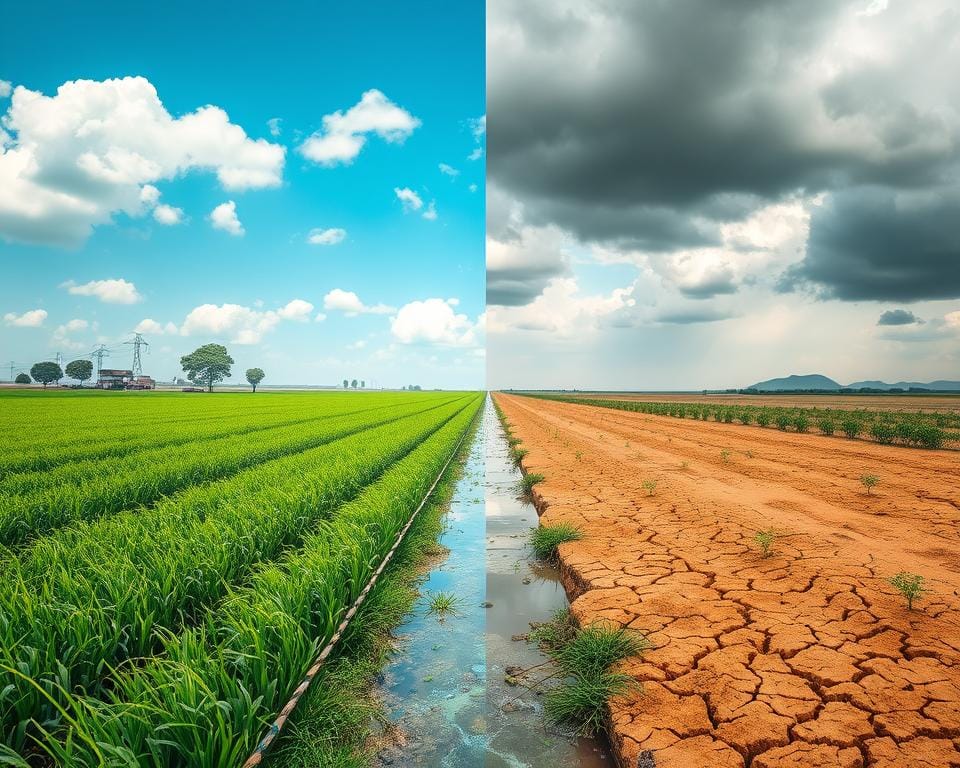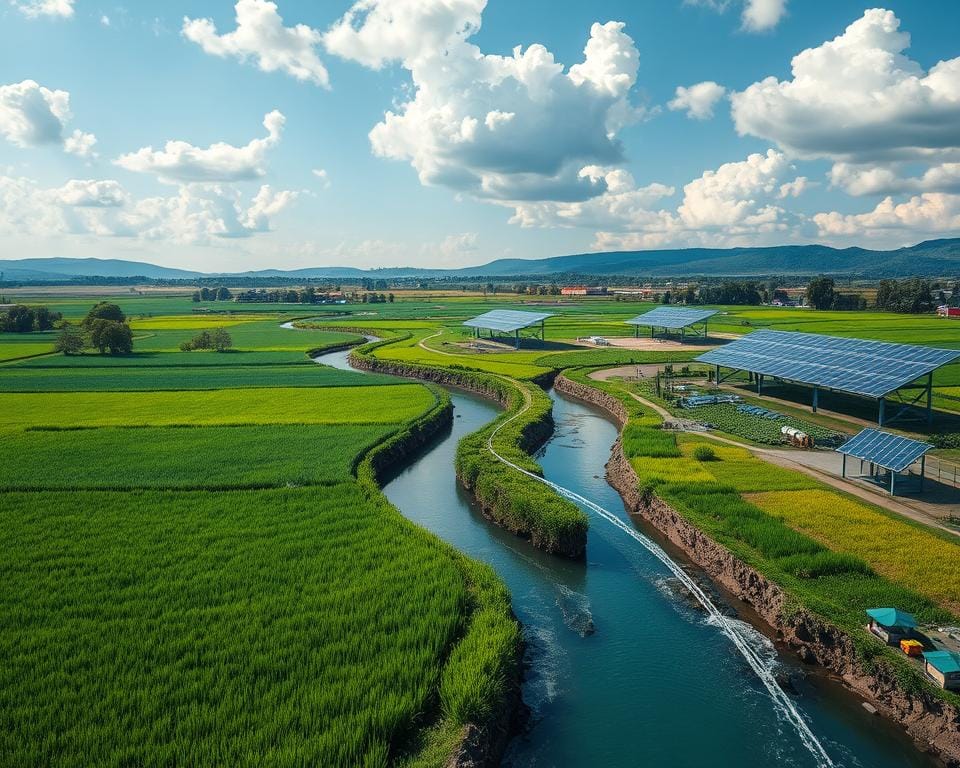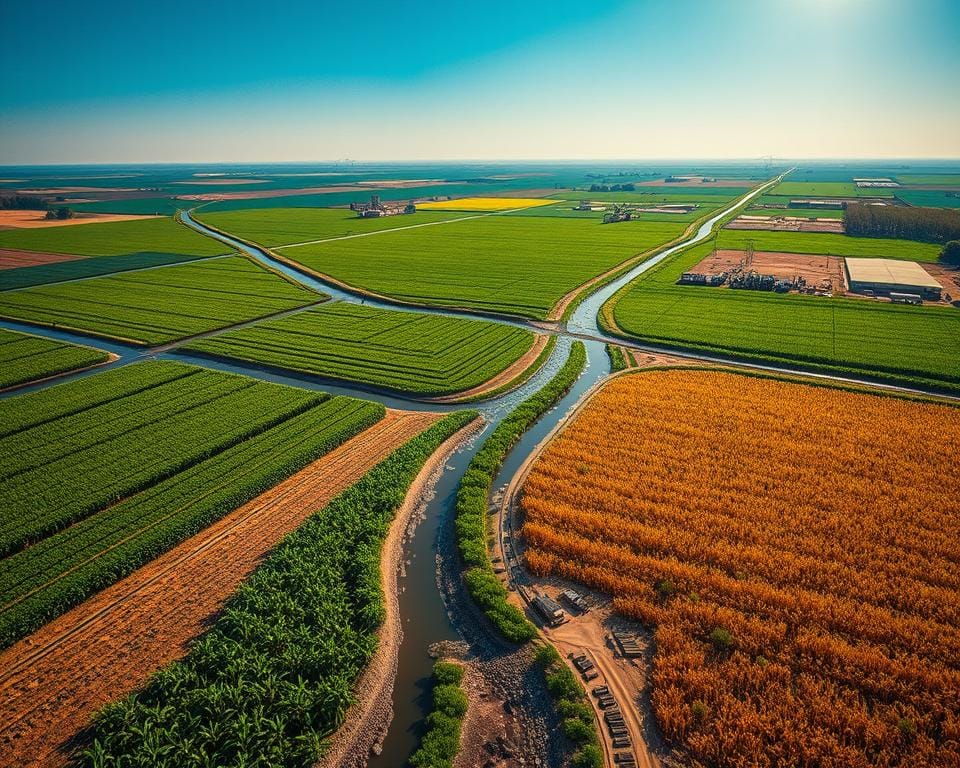Agriculture uses almost 70 percent of the world’s freshwater. To feed one person every day takes 3,000 liters of water. This is much more than the two liters we drink.
The need for food will make agriculture production go up 70 percent by 2050. This will put more pressure on our water resources. Climate change and water scarcity make it even harder for farming to be sustainable.
We must have good governance and policies to tackle these issues. Ensuring reliable water delivery, fair access, and better efficiency is key. Using non-traditional water sources like treated wastewater can help too.
To manage water in farming better, we need sustainable practices. This includes planning when to irrigate, capturing rainwater, and using renewable energy for pumping water. These steps can lead to better and sustainable use of water in agriculture.
Introduction to Water Use in Agriculture
Water is key for agriculture as it helps keep crops healthy, yields high, and supports sustainable farming. With the world’s population growing and food demand rising, managing water in farming is more important than ever.
The Importance of Water in Agriculture
Knowing why water is vital for farming helps us find better ways to boost farm output. Good water management allows for more types of crops and helps farms adjust to weather changes. Techniques like drip irrigation and careful water use are key to saving water and making sure it’s used well.
Overview of Water Consumption in Agriculture
Since 1900, global freshwater use has jumped six times, mainly due to economic growth and the demand for more resources. Amazingly, agriculture uses about 70% of the world’s freshwater. Places like South Asia and the Middle East especially depend on watering their crops, with some countries irrigating over 20% of their farm land. In the U.S., farmers used 118,000 million gallons of water per day in 2015, showing just how much water farming needs.
Challenges in Agricultural Water Use
Farm water use faces problems like soil getting too salty, less water available, and harming ecosystems, which endangers wildlife. The CAP 2023-27 plan works to protect water better and supports sustainable farming methods. Eco-schemes now encourage actions to take better care of soil and manage nutrients well. These steps are part of tackling the big issue of not having enough water worldwide, which asks for ongoing creativity and sustainable water use to ensure water for the future.
Understanding Local Water Resources
Understanding local water resources is key to using water wisely in farming. These resources include things like rivers, underground water, and even recycled water. Knowing what’s available helps farmers use water more efficiently.
Types of Water Sources
Water sources vary widely. Rivers, lakes, and man-made reservoirs are critical for watering crops. Underground aquifers are another major source. In 2010, the U.S. used about 230,000 million gallons of fresh surface water per day for various needs.
There’s also treated wastewater and sea water made fresh, though they’re less common. Globally, these unconventional sources provide about 1% of farming water. Yet, they’re becoming more important for dry areas.
Factors Affecting Water Extraction Methods
Choosing how to get water involves many factors. Things like location, depth to groundwater, and water type matter a lot. Techniques to calculate water loss to the air help plan how much water crops need.
Today, advances and renewable energy are improving these methods. Areas like the Mediterranean and Middle East benefit greatly from such technologies.
explore non-conventional water sources
The Role of Non-Conventional Water Sources
Unusual water sources are key in fighting the lack of water. Reused water, desalinated water, and collected rain are innovative approaches. They help make more water available for agriculture.
With farming using a huge part of the world’s water, these new sources can really ease the strain. They offer a more sustainable way to meet agriculture’s water needs.
Groundwater in Agriculture
Groundwater is crucial for agriculture around the world. It makes up nearly half of the drinking water supply. This water is vital for irrigation, as it provides a large part of the water that crops need. Yet, its sustainability is at risk due to overuse and pollution, which are often caused by farming.
What is Groundwater?
Groundwater is water that’s found under the earth’s surface. It fills up spaces in soil and cracks in rocks. It gets there from rain and surface water soaking into the ground. In places without much surface water, groundwater is key for farming. It helps grow various crops, playing a big role in global food security.
Impact of Agricultural Activities on Groundwater
The impact of farming on groundwater is significant. Using too much fertilizer and pesticides can harm it. So can heavy machines that compact the soil. These problems can cause less groundwater to recharge and pollute it. Taking out too much water for crops lowers the water levels and makes getting water more expensive.
Climate change and more people also add stress, creating conflicts over water in farming areas. Challenges include less resistance to drought, sinking land, seawater mixing with groundwater, and harm to ecosystems relying on groundwater.
Strategies for Sustainable Groundwater Management
To fix these issues, we need to focus on keeping groundwater sustainable. This means checking on groundwater often and planning irrigation carefully. We should use smart farming practices, like rotating crops and tilling the land in a way that saves water. Also, making water more expensive can help use less of it. For example, raising the cost to get water by 10% could reduce how much water we take from the ground by 3.6%.
To reach bigger goals, like California’s plan to cut groundwater use by 19%, tougher steps may be needed. This could include a tax on taking groundwater, which might make farmers use less water-heavy crops. Such a tax could lead farmers to change about 9% of farmland to different uses, reducing the growth of water-intensive crops like fruits and nuts.
| Challenge | Impact | Solution |
|---|---|---|
| Overexploitation | Reduced water tables, increased production costs | Groundwater pricing, sustainable management practices |
| Soil Compaction | Decreased groundwater recharge | Conservation tillage, crop rotation |
| Climate Change | Increased conflicts over water resources | Climate change adaptation strategies |
| Pollution | Contamination of groundwater | Proper use of fertilizers and pesticides, managed aquifer recharge |
Environmental and Socio-Economic Impacts of Irrigation
Irrigation is key to agriculture, improving productivity and affecting the environment. It has many impacts, as highlighted in the irrigation impacts discussion.

Irrigated land makes up about 16% of all farming areas. Yet, it drives roughly 40% of the total crop yield. This shows that irrigated fields are way more productive, boosting food security and helping farm communities thrive.
Irrigation’s impact on the environment has both good and bad sides. For example, in India, 60% of the Ganges river water is diverted. This boost in agriculture causes water shortages downstream. Pakistan’s Indus River faces similar issues, affecting fish and local lives.
On the Nile River, too much water taken for crops means it sometimes doesn’t reach the sea. This shows the need to balance farming needs with keeping river ecosystems healthy.
The Aral Sea’s story is a warning. Excessive water use for irrigation has shrunk its size. The area’s ecosystem and people have suffered greatly because of this.
| Region | Key Impact | Outcome |
|---|---|---|
| Ganges, India | 60% river flow diverted | Water scarcity downstream |
| Indus, Pakistan | Over-extraction of water | Threat to fish populations |
| Nile, Africa | High withdrawal during dry periods | River fails to reach the sea |
| Aral Sea, Central Asia | River water interception | Environmental catastrophe |
In Mali, irrigation has greatly improved lives over 20 years. Nearly 1,000 projects have upped farm productivity, health, and peace. Better water use and pumps have boosted crop yield significantly.
A detailed Mali study showed kids in irrigated areas were healthier. There was also less fighting, showing wider social benefits beyond just farming improvements.
Acknowledging both good and bad sides of irrigation is critical. With sustainable methods, we can raise crop yields without hurting our planet. This way, communities can live in peace with nature.
Improving Irrigation Efficiency
To sustain agriculture, it’s crucial to maximize irrigation efficiency. Especially since over 70% of the world’s freshwater goes to agriculture. By using water-saving techniques and best practices, we can save a lot of water in farming.
Tips for Efficient Water Use
- Optimize irrigation piping placement to ensure water is evenly distributed across crop fields.
- Integrate large trees within crop areas to minimize evaporation and reduce water needs.
- Regularly monitor water consumption to detect and address inefficiencies promptly.
Technologies and Tools for Better Irrigation
Today’s technology offers tools to make watering crops more efficient. Techniques like drip irrigation and smart sensors help use less water but still keep crops healthy.
- The Water Requirement Tool aids farmers in determining precise water needs for different crops, preventing wastage.
- Incorporating systems like the Saaras sprinkler can enhance water distribution and reduce overall consumption.
- Soil testing technologies help optimize water and nutrient use by providing accurate data about soil conditions.
Best Practices for Conserving Water
For water conservation in farming, it’s vital to follow sustainable practices. Things like crop rotation, conservation tillage, and mulching help keep the soil moist. This means less water is needed for irrigation.
| Practice | Benefits |
|---|---|
| Crop Rotation | Improves soil structure and reduces water loss |
| Conservation Tillage | Helps retain soil moisture and prevent erosion |
| Mulching | Reduces evaporation and maintains soil temperature |
Sustainable Water Resource Management
To manage water in farming sustainably, we need good governance and new ways to save water. This helps farms use water wisely and keeps it safe for everyone in the future.
Effective Governance and Policies
Good management is vital for sustainable water use. The right farm policies encourage smart water use, making sure it is shared fairly. With rules and rewards for saving water, officials can guide how farmers use water.
Drip irrigation saves a lot more water than old methods and is popular because of helpful policies. Collecting rainwater also lessens the need for water from other places, making farming more self-sufficient.
Innovative Solutions for Water Conservation
New technologies are changing how we save water in farming. Tools like soil moisture sensors and solar-powered irrigation help manage water better. This means less waste and more crops.

Drip irrigation systems put water right where plants need it. This cuts down on water, fertilizer, and energy use and increases crop amounts. It also stops water pollution and soil from washing away, which helps farms last longer.
Futurepump’s solar pumps are a big help for farmers. They pump 1,600 to 3,600 liters of water per hour. These tools make farming more sustainable by fitting water management into daily farm work.
Using water wisely in farming does more than save water. It also helps plants grow better and makes farms more profitable. With smart policies and new solutions, farmers can do well while caring for the environment.
Learn more about effective water management. See how these ideas can change farming for the better.
Data-Driven Insights
Using data helps manage water resources well. For example, planning when and how much to water plants makes irrigation more effective. It avoids both wasting water and hurting crops, which can save both water and energy.
Combining good information, new technology, and helpful policies is key for keeping water and farming in balance. This is crucial for feeding more people around the world.
Conclusion
Looking into the future, it’s clear that improving how we use water in farming is key. We need a mix of new technology and old water-saving ways. Making farming more sustainable is critical. For example, Joseph Poore and Thomas Nemecek (2018) show these methods greatly reduce water waste. This leads to better crops and healthier livestock.
It’s also important to keep water clean for use in farming. Clean water is needed to wash fruits and veggies. This makes sure they are safe to eat by removing bad stuff like pesticides. Also, clean drinking water for animals helps them grow well and stay healthy. Good water quality means better crops, more food, and safer agriculture.
Bad water management is a big problem, made worse by climate change. It causes less reliable water supplies, lower crop yields, and more stress on water sources. But, using smart irrigation like drip systems can make a big difference. These systems use water much more efficiently. Also, collecting rainwater and using cover crops can help save water. Precision agriculture tools also help save water and improve crop growth.
In the end, making sure we use water wisely in farming depends on teamwork and dedication to sustainable ways. We need to work together and commit to keeping our water clean and managing it well. This way, farming can succeed without wasting our precious water resources. This is vital for our environment and everyone’s future. To learn more, you might like this long walk to water audiobook.

